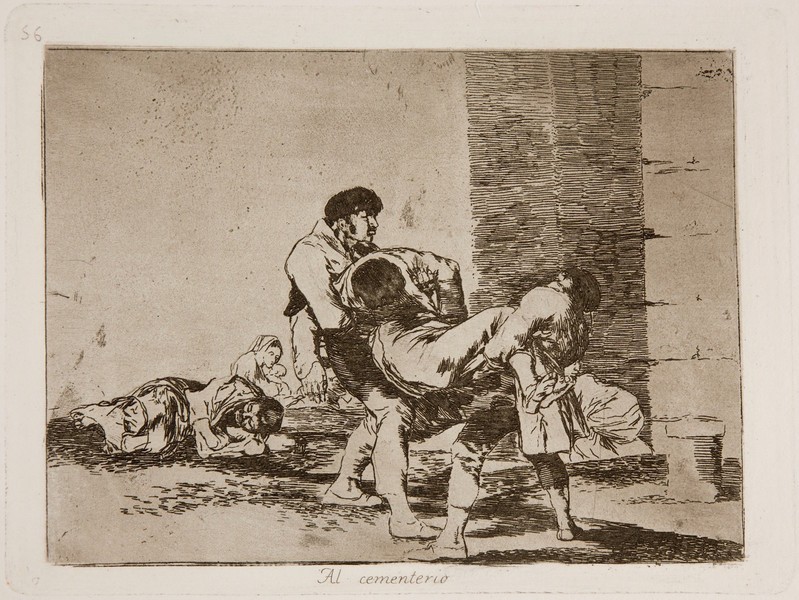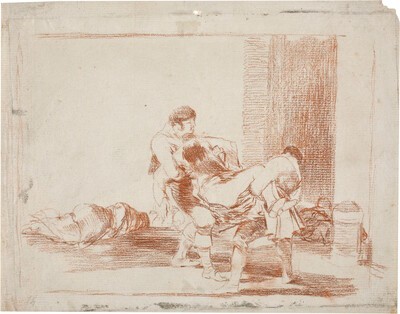- Cronología
- Ca. 1812 - 1815
- Dimensiones
- 156 x 208 mm
- Técnica y soporte
- Etching, lavis and drypoint
- Reconocimiento de la autoría de Goya
- Undisputed work
- Ficha: realización/revisión
- 19 Dec 2010 / 01 Jun 2023
- Inventario
- 225
30 (on the lower left-hand corner of the plate).
See Sad presentiments of what must come to pass.
The second artist's proof shows horizontal lines that shade in an area between the elbow and thigh of the figure located on the far right of the print.
The title was handwritten on the print by Goya in the first and only series that is known to have been printed at the time the works were created, which the artist gave to his friend Agustín Ceán Bermúdez. Therefore, the title was etched into the plate at a later date and left unchanged as of the first edition of the Disasters of War printed by the San Fernando Royal Academy of Fine Arts in Madrid in 1863, after the printing of the series in the possession of Ceán Bermúdez.
There is a surviving preparatory drawing for this print which is housed in the Prado Museum in Madrid.
Two men are carrying a body. One of the men, shown side-on, is carrying the legs of the body, while the other placed further into the background grasps the corpse by the waist, causing the head of the corpse to slump forward, obscuring the face. In the background there is another lifeless body waiting to be taken to the cemetery. A short distance behind this figure, a woman holds a child in her arms.
The image depicts the transport of dead bodies to the cemetery, one of the greatest problems following the massive increase in deaths caused by the famine of 1811 to 1812. For public health reasons, it was prohibited to take corpses to churches or chapels, and it was decided that all bodies should be deposited in public cemeteries on the outskirts of the city.
Juan Carrete suggests that this image of two men carrying a body could be read as a secular interpretation of the burial of Christ. He even proposes a possible source of inspiration for the print: The Entombment of Christ by Caravaggio (Milan, 1571 - Port Ercole, 1610) which Goya might have seen either during his trip to Italy between 1769 and 1771 or by means of a print reproducing the work.
The plate is stored in the National Chalcography (cat. 307).
-
Goya and his timesThe Royal Academy of ArtsLondon1963cat. 66cat. 248
-
Francisco de GoyaMuseo d'Arte ModernaLugano1996exhibition celebrated from September 22nd to November 17th.cat. 56
-
Francisco de Goya: Maleri, Tegning, GrafikkNasjonalgallerietOslo1996from 10th to April 14th 1996cat. 146
-
Francisco Goya. Sein leben im spiegel der graphik. Fuendetodos 1746-1828 Bordeaux. 1746-1996Galerie KornfeldBern1996from November 21st 1996 to January 1997cat. 140
-
Francisco Goya. Capricci, follie e disastri della guerraSan Donato Milanese2000Opere grafiche della Fondazione Antonio Mazzottacat. 136
-
Goya. Opera graficaPinacoteca del Castello di San GiorgioLegnano2006exhibition celebrated from December 16th 2006 to April 1st 2007p. 79
-
Goya et la modernitéPinacothèque de ParisParís2013from October 11st 2013 to March 16th 2014cat. 95
-
2022
-
Goya, grabadorMadridBlass S.A.1918cat. 158
-
Goya engravings and lithographs, vol. I y II.OxfordBruno Cassirer1964cat. 176
-
Vie et ouvre de Francisco de GoyaParísOffice du livre1970cat. 1086
-
Catálogo de las estampas de Goya en la Biblioteca NacionalMadridMinisterio de Educación y Cultura, Biblioteca Nacional1996cat. 267
-
ParísPinacoteca de París2013p. 147
-
Goya. In the Norton Simon MuseumPasadenaNorton Simon Museum2016pp. 114-151
-
Museo de Bellas Artes de Badajoz y Diputación de Badajoz2022p. 77

